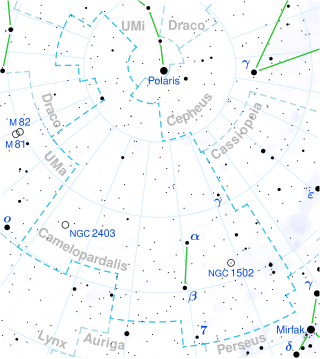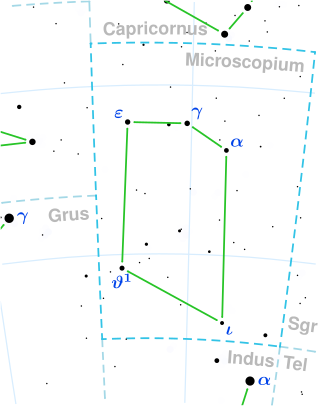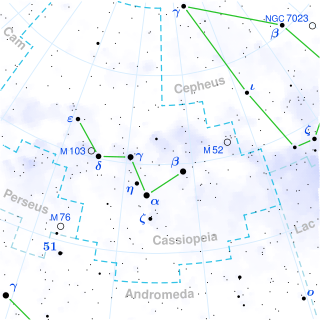HD 92845 is a probable astrometric binary in the southern constellation Antlia. It has an apparent magnitude of 5.62, allowing it to be faintly seen with the naked eye. Parallax measurements place the system at a distance of 790 light years and it is currently receding with a heliocentric radial velocity of 4.5 km/s.

HD 24479, also designated as HR 1204, is a solitary, bluish-white hued star located in the northern circumpolar constellation Camelopardalis. The star is visible to the naked eye with an apparent visual magnitude of 5.04. Based on Gaia DR3 parallax measurements, it is located 385 light years from the Sun. However, it is receding with a somewhat constrained heliocentric radial velocity of 4.6 km/s. At its current distance, HD 24479's brightness is diminished by 0.29 magnitudes due to interstellar dust.

Q Scorpii, also designated as HD 159433, is an astrometric binary located in the southern zodiac constellation Scorpius. It has an apparent magnitude of 4.27, making it readily visible to the naked eye under ideal conditions. It lies in the tail of Scorpius, between the stars λ Scorpii and μ Scorpii and is located 7′ away from the faint globular cluster Tonantzintla 2. Based on parallax measurements from Gaia DR3, the system is estimated to be 158 light years distant, but is approaching the Solar System with a heliocentric radial velocity of −49 km/s.

2 Piscis Austrini, also known as HD 200763 or simply 2 PsA, is a solitary orange hued star located in the southern constellation Microscopium. It was once part of Piscis Austrinus, the southern fish. The object has an apparent magnitude of 5.2, making it faintly visible to the naked eye under ideal conditions. Based on parallax measurements from the Gaia satellite, it is estimated to be 354 light years away from the Solar System. However, it is receding with a poorly constrained heliocentric radial velocity of 3.1 km/s. At its current distance, 2 PsA's brightness is diminished by 0.11 magnitudes due to interstellar dust. It has an absolute magnitude of 0.19.
HD 138867, also known as HR 5786, is a bluish-white hued star located in the southern circumpolar constellation Apus. It has an apparent magnitude of 5.94, making it faintly visible to the naked eye if viewed under ideal conditions. Based on parallax measurements from the Gaia spacecraft, it is estimated to be 417 light years away from Earth. However, it is receding with a heliocentric radial velocity of 1.1 km/s.

HD 57197, also known as M Puppis or HR 2789, is a suspected astrometric binary located in the southern constellation Puppis, the poop deck. It has an apparent magnitude of 5.84, making it faintly visible to the naked eye under ideal conditions. Based on parallax measurements from the Gaia satellite, the system is estimated to be 629 light years away from the Solar System. The value is poorly constrained, but it appears to be receding with a heliocentric radial velocity of 13 km/s. At its current distance, HD 57197's brightness is diminished by 0.3 magnitudes due to interstellar dust. It has an absolute magnitude of -0.43.

HD 26764, also known as HR 1314 or rarely 14 H. Camelopardalis, is a solitary white hued star located in the northern circumpolar constellation Camelopardalis. It has an apparent magnitude of 5.19, making it faintly to the naked eye if viewed under good conditions. Gaia DR3 parallax measurements place the object at a distance of 266 light years and is drifting closer with a poorly constrained heliocentric radial velocity of 3 km/s. At its current distance, HD 26764's brightness is diminished by 0.26 magnitudes due to interstellar dust.

HD 171819, also known as HR 6986 or rarely 22 G. Telescopii, is a solitary star located in the southern constellation Telescopium. It is faintly visible to the naked eye as a white-hued object with an apparent magnitude of 5.84. The object is located relatively close at a distance of 313 light years based on Gaia DR3 parallax measurements, but it is approaching the Solar System with a heliocentric radial velocity of −9 km/s. At its current distance, HD 171819's brightness is diminished by one-quarter of a magnitude due to interstellar dust and it has an absolute magnitude of +0.65.

23 Leonis Minoris is a solitary, bluish-white hued star located in the northern constellation Leo Minor. It is positioned 7° south and 11" west from β Leonis Minoris. It is rarely called 7 H. Leonis Minoris, which is its Hevelius designation.

40 Leonis Minoris is a white hued star located in the northern constellation Leo Minor. It is rarely called 14 H. Leonis Minoris, which is the designation given by Polis astronomer Johann Hevelius.

HD 26755, also known as HR 1313, is a spectroscopic binary located in the northern circumpolar constellation Camelopardalis, the giraffe. It has an apparent magnitude of 5.72, making it faintly visible to the naked eye under ideal conditions. Gaia DR3 parallax measurements place the system at a distance of 271 light years and is currently drifitng closer with a heliocentric radial velocity of −38 km/s. At its current distance, HD 26755's brightness is diminished by 0.19 magnitudes due to interstellar dust.

HD 168592, also designated as HR 6862 or rarely 7 G. Coronae Australis, is a solitary star located in the southern constellation Corona Australis. It is faintly visible to the naked eye as an orange-hued star with an apparent magnitude of 5.07. Gaia DR3 parallax measurements place it at a distance of 490 light years and is currently receding with a heliocentric radial velocity of 18 km/s. At its current distance, HD 168592's brightness is diminished by 0.38 magnitudes due to interstellar dust. It has an absolute magnitude of −0.76.

HD 31134, also designated as HR 1561, is a solitary star located in the northern circumpolar constellation Camelopardalis, the giraffe. It is faintly visible to the naked eye as a white-hued star with an apparent magnitude of 5.74. Gaia DR3 parallax measurements place it 473 light years away. It appears to be approaching the Solar System with a heliocentric radial velocity of −15.1 km/s. At its current distance, HD 31134's brightness is diminished by 0.35 magnitudes due to interstellar dust. It has an absolute magnitude of +0.19.

32 Leonis Minoris, also known as HD 90840, is a solitary star located in the northern constellation Leo Minor. It is faintly visible to the naked eye as a white-hued point of light with an apparent magnitude of 5.78. The object is located relatively far at a distance of 729 light-years based on Gaia DR3 parallax measurements and it is currently receding with a heliocentric radial velocity of 2 km/s, which is somewhat constrained. At its current distance, 32 LMi's brightness is diminished by 0.14 magnitudes due to interstellar extinction and it has an absolute magnitude of −1.02.

HD 33541, also known as HR 1683, is a white-hued star located in the northern circumpolar constellation Camelopardalis. It has an apparent magnitude of 5.83, making it faintly visible to the naked eye. Gaia DR3 parallax measurements imply a distance of 358 light years and it is currently receding with a heliocentric radial velocity of 9.9 km/s. At its current distance HD 33541's brightness is diminished by 0.16 magnitudes due to interstellar extinction and it has an absolute magnitude of +0.58.

HD 28780, also known as HR 1440, is a solitary white-hued star located in the northern circumpolar constellation Camelopardalis. It has an apparent magnitude of 5.91, making it faintly viisble to the naked eye under ideal conditions. Gaia DR3 parallax measurements imply a distance of 488 light-years, and it is currently drifting closer with a heliocentric radial velocity of −22.6 km/s. At its current distance, HD 28780's brightness is diminished by 0.33 magnitudes due to interstellar extinction and it has an absolute magnitude of +0.26.
HD 177365 is a visual binary located in the southern constellation Telescopium. It has an apparent magnitude of 6.27, placing it near the limit for naked eye visibility, even under ideal conditions. Gaia DR3 parallax measurements imply a distance of 373 light-years and it is currently receding with a heliocentric radial velocity of 15.5 km/s. At its current distance, HD 177365's brightness is diminished by two-tenths of a magnitude due to interstellar extinction and it has an absolute magnitude of +0.16.

HD 120565, also designated as HR 5203, is a star located in the northern circumpolar constellation Camelopardalis. It is faintly visible to the naked eye as an orange-hued point of light with an apparent magnitude of 5.91. Gaia DR3 parallax measurements imply a distance of 370 light-years and it is currently drifting closer with a heliocentric radial velocity of −45.2 km/s. At its current distance, HD 120565's brightness is diminished by 0.12 magnitudes due to interstellar extinction and it has an absolute magnitude of +0.48.
HD 181295 is a star located in the southern constellation Telescopium. It has an apparent magnitude of 6.42, placing it near the limit of naked eye visibility, even under ideal conditions. The object is located relatively close at a distance of approximately 252 light-years based on Gaia DR3 parallax measurements, and it is currently drifting closer with a heliocentric radial velocity of −35.7 km/s. At its current distance, HD 181295's brightness is diminished by 0.22 magnitudes due to interstellar extinction and it has an absolute magnitude +2.14.

HD 4222, also known as HR 196, is the primary of a binary star located in the northern constellation Cassiopeia. It is faintly visible to the naked eye as a white-hued point of light with an apparent magnitude of 5.41. Gaia DR3 parallax measurements imply a distance of 353 light-years and it is drifting closer with a heliocentric radial velocity of −8.5 km/s. At its current distance, HD 4222's brightness is diminished by an interstellar extinction of 0.13 magnitudes and it has an absolute magnitude of +0.44.









